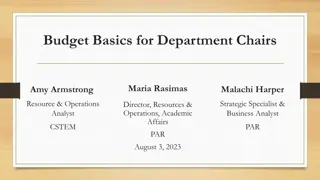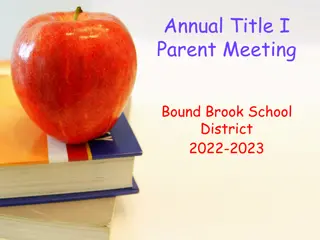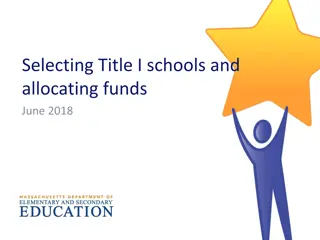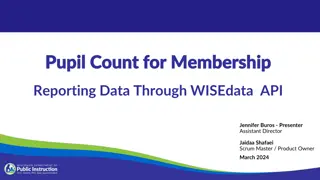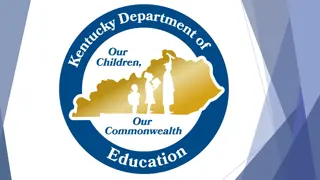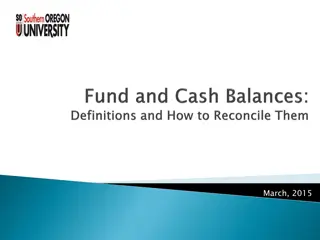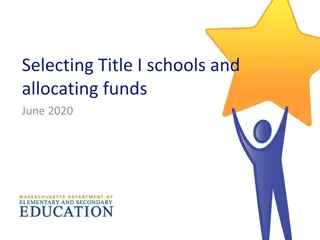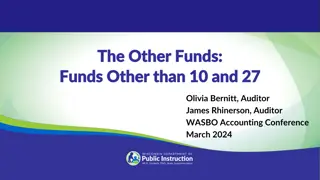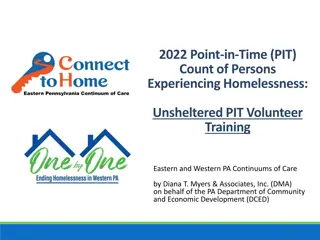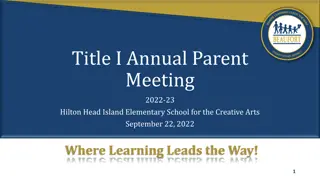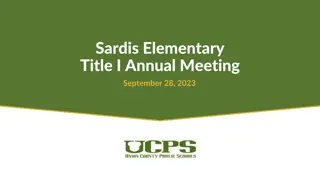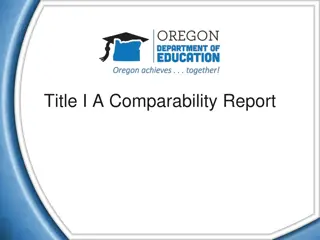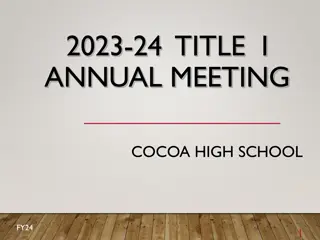Understanding the Annual Count Process for Title I, Part D Funds
The Annual Count is a crucial survey to estimate students eligible for Title I, Part D funds in each state. This overview discusses the process, relationship between counts and final allocations, coordinator's role, key aspects for success, and details on the two parts of the survey. Key points include hold-harmless provisions, national fluctuations, and the importance of accurately verifying and submitting counts to the U.S. Department of Education.
Download Presentation

Please find below an Image/Link to download the presentation.
The content on the website is provided AS IS for your information and personal use only. It may not be sold, licensed, or shared on other websites without obtaining consent from the author. Download presentation by click this link. If you encounter any issues during the download, it is possible that the publisher has removed the file from their server.
E N D
Presentation Transcript
1 (Almost) Everything You Need To Know About the Annual Count
What Is the Annual Count? The Annual Count is an annual survey that collects an estimate of the number of students who are eligible for Title I, Part D (TIPD), funds in each State. Eligibility for counting and eligibility for serving are different! The U.S. Department of Education (ED) uses Annual Count data (along with other data) from each State in formula calculations for the State for both Subpart 1 and Subpart 2. 2
Annual Count Process: An Overview (5) ED announces preliminary awards in April/May and releases funds in July (1) ED distributes the Annual Count Survey and guidance (mid-October) (4) ED prepares funding tables based on counts and funds available (2) Child count periods are selected (3) SEAs submit counts to ED (January) 3
The Relationship Between the Count and Final Allocations Finite Funding: Approximately the same amount of funds is allocated to Part D every year. National Fluctuations: Although your counts may change significantly, they may be counterbalanced by changes in other States OR you could greatly benefit, depending on the changes. Hold Harmless: If States experience a significant decrease in counts one year, they are protected by hold-harmless provisions 4
Role of the Part D Coordinator To understand the counting requirements To provide technical assistance to subgrantees To partner with State and local agencies to collect an accurate count of students To verify and submit the count to ED 5
Key Pieces To Conduct the Annual Count Successfully Understand the nuances of the instructions and guidance (who can be counted and when) Understand the difference between counting, serving, and the Consolidated State Performance Report (CSPR) Know where to find the resources to assist you 6
Two Parts of the Count Survey Part 1 of the Survey = Local Education Agency (LEA) Section Count of students who are delinquent (Part D, Subpart 2, funds) Count of students who are neglected (Title I, Part A, funds) Part 2 of the Survey = State Agency (SA) Section Count of students who are neglected or delinquent (Part D, Subpart 1, funds) 7
Annual Counts for State Agency Programs Under Subpart 1 THE 1-DAY COUNT 8
State Agency/Subpart 1 Annual Count: Eligibility State Agency Eligibility Agencies responsible for providing free public education to children and youth who are in N or D institutions, community day programs, or adult correctional institutions Facility Eligibility Facilities that serve children and youth who are neglected OR delinquent AND have an average length of stay of at least 30 days Student Eligibility Students who are aged 20 years or younger Students who are enrolled in a State-funded regular program of instruction for at least 15 hours/week if in an adult facility or 20 hours/week in a juvenile facility or community day program 9
The S1 Count Window (a.k.a. Count Day) and Formula Eligible SAs select a date Each State agency may select any 1 day during the current calendar year. Each SA may select its own date, but every institution under a particular SA must use the same date. SEAs may also work with SAs to select a date to use for all SAs. SAs or facilities adjust the count to reflect the length of the school year of the specific agency or institution (single day count) (length of school year in days) 180 10
State Agency/Subpart 1 Program: Students Counted vs. Students Served Students Counted (Annual Count) In a program for youth who are N or D, including juvenile and adult correctional facilities and community day programs Enrolled in a State-funded regular program of instruction * Enrolled in a program that has an average length of stay of at least 30 days on day of count during the calendar year 20 years of age or younger Students Served In a program for youth who are N or D, including juvenile and adult correctional facilities and community day programs Enrolled in a State-funded regular program of instruction Enrolled in a program that meets the length-of-stay requirements for a given program type (requirements vary) 21 years of age or younger * A regular program of instruction is defined as an educational program that consists of classroom instruction in school subjects such as reading and math. For a juvenile facility, the program must provide at least 20 hours of instruction per week; for an adult facility the program must provide at least 15 hours of instruction per week. 11
Annual Counts for Local Agency Programs Under Subpart 2 THE 30-DAY COUNT OR THE OCTOBER COUNT 12
The Different Purposes of the N and D Count Same Rules, Same Form, Different Funding Streams* Students in Neglect Programs = Title I, Part A Students in Delinquent Facilities = Title I, Part D, Subpart 2 *This highlights the distinctions between counting, funding, and serving in Subpart 2 13
Local Education Agency/Subpart 2 AND Part A Annual Count: Eligibility LEA Eligibility LEAs with children and youth in locally operated N or D facilities not operated by the State, including public or private institutions Facility Eligibility Locally operated facilities that meet the definition of an institution for children and youth who are neglected, an institution for children and youth who are delinquent, or an adult correctional institution Facilities need not have a 30-day average length of stay. Student Eligibility Students 5 17 years old Students NOT counted in the State agency/Subpart 1 Annual Count Students who reside at a residential institution or facility for at least 1day within the 30-day count window (1day of which must be in October) 14
Facility Eligibility and Designation Each eligible facility must be designated as a neglect OR delinquent institution, but not both, even if it serves both. A facility should maintain consistency with how it was designated last year. If a facility has never counted before or its charter has changed, designate it according to its charter. If a facility s charter is not clear or unavailable and the facility never counted before, designate the facility based on its enrollment. 15
The 30-Day Count Window SEAs or eligible LEAs select a 30-day count window. At least 1 day in the 30-day window must be in October. SEAs can set the 30-day window for all LEAs to use, or elect to allow LEAs and facilities to select their own windows. Count each unique case/enrollment in a facility s caseload. Any given student has to be enrolled for only 1 day. Unique refers to unique commitment, enrollment, and discharge periods. 16
Local Agency/Subpart 2 Program: Students Counted vs. Students Served Students Counted (Annual Count) Students Served Living in local institutions for children and youth who are N or D or adult correctional institutions Living in local institutions for children and youth who are delinquent or in adult correctional institutions; eligible for services under Title I, Parts A and C; or identified as at risk (e.g., migrants, immigrants, gang members, pregnant or parenting youth)* Living in the institution for at least 1 day during the 30-day count period 5 17 years of age 21 years of age or younger * Neglect and at-risk programs may receive Subpart 2 funding and services per the Title I, Part D, statute even though students in those programs are not included in the count upon which Part D funding allocations are based. 17
Final Clarification: Annual Count vs. the CSPR Students in the Annual Count Students in the CSPR Unduplicated Count Purpose: to track student achievement Purpose: to determine formula counts for allocating funds Instructions do not differ per Subpart. Instructions differ per Subpart. Adult corrections = Subpart 1 A subset of eligible students enrolled during a specific time period within the calendar year At-risk programs = Subpart 2 ALL students who benefitted from Part D funding during the school year Adjustments are made to calculations to estimate the student population (SA/Subpart 1). Unduplicated counts are not adjusted they are actual counts of the total population served. Multiple enrollments within a facility can be counted (LEA/Subpart 2). Students are counted once per facility, regardless of multiple enrollments. 18
Counting-Specific Resources All Centrally Located on the NDTAC Site!! U.S. Department of Education (ED) counting guidance, worksheets, and survey forms NDTAC TIPD Annual Count Guide Checklists for both subparts NDTAC s Webinar The Annual Count: Understanding the Process and Its Implications Download and use this in your own trainings. Title I, Part D, Statute Title I, Part D, Nonregulatory Guidance 19
What You Can Do To Enhance Count Efficiency and Accuracy Understand all the requirements and the process. Be proactive and provide T/TA in advance. Provide technical assistance in a way that best suits your resources and subgrantees. Develop materials and include eligibility requirements and supplemental instructions with the survey. Implement a verification process and do what works for your State. 20
Local Educational Agency/Subpart 2 Annual Count: Counting Quiz 2 How many students who reside in a facility designated as a delinquent institution should be counted ? Tim, Linda, and Jennie are considered delinquent and Bobby is considered neglected. Sun Mon Tue Wed Thu Fri Sat Tim Linda Bobby Tim Linda Bobby Tim Linda Bobby Tim Linda Bobby Tim Linda Bobby Tim Linda Bobby Tim Linda Bobby Tim Linda Bobby Tim Linda Bobby Tim Linda Bobby Tim Linda Bobby Tim Linda Bobby Tim Linda Bobby Tim Linda Bobby Tim Linda Tim Linda Tim Linda Tim Tim Tim Tim Tim Tim Tim Tim Tim Tim Tim Tim Jennie Tim Jennie Delinquent Child Count = 4 22
Local Educational Agency/Subpart 2 Annual Count: Count Window September S M T October November S M T W T S M T W T F S F S W T F S 1 1 2 3 4 5 6 1 2 3 2 3 4 5 6 7 8 7 8 9 10 11 12 13 4 5 6 7 8 9 10 9 10 11 12 13 14 15 14 15 16 17 18 19 20 11 12 13 14 15 16 17 16 17 18 19 20 21 22 21 22 23 24 25 26 27 18 19 20 21 22 23 24 23 24 25 26 27 28 29 28 29 30 31 25 26 27 28 29 30 30 An LEA s Subpart 2 count window can start as early as September 2 or as late as October 31. The window must be for 30 consecutive days and at least 1 day of that window must be in October. The SEA may set the window for all LEAs, or it may allow LEAs and facilities to choose their windows independently. 23
Keeping Title I, Part D, True to Its Purpose: Planning and Funding Based on Needs and Outcomes
Objectives Participants will better understand: The important differences between Subparts 1 and 2 The differences between counting for and allocating Part D funds The necessity of using needs assessments and formal agreements Their roles as training and technical assistance (TA) providers, collaborators, and relationship builders 25
Subpart 1 vs. Subpart 2 Subpart 1 is quite straightforward. State plan Supplement not supplant Transition reservation Subpart 2 is far more open. Different/more complicated counting process No supplement not supplant clause Part A reservation 26
Counting for vs. Administering Funds Different eligibility requirements Different reporting requirements and timeframes Annual Child Count Consolidated State Performance Report (CSPR) The youth themselves are different. 27
Administering Funds Allocating and Managing Part D Dollars 28
Why Plan Your Funding? To be more effective Foster better outcomes for youth. Meet Federal, State, and local requirements. Meet program, agency, and facility goals and mandates. Ensure future Federal program funding. To be more efficient Do more with less in times of financial struggle. Effectively administer Part D along with other responsibilities. 29
Your Roles in the Funding Process Manager/coach Training and TA provider Monitor Data collector and analyzer Program improvement leader 30
Fund Allocation Steps 1. State plans 2. Application development a. Needs assessment b. Formal agreements 3. Application review a. Use of funds proposals 4. Fund allocation and TA 31
Step 1: Know Your State Plan Read your State plan! It is The foundation of your Part D program An agreement with the ED Know when to change it, when these occur: New understandings of Part D Changes in populations and/or needs Reauthorization 32
The State Plan A plan: A. For meeting the educational needs of children and youth who are neglected, delinquent, and at-risk; B. For assisting in the transition of children and youth from correctional facilities to locally operated programs; and C. That is integrated with other programs under this Act or other Acts, as appropriate. 33
The State Plan (cont.) Each State plan shall: A. Describe the program goals, objectives, and performance measures established by the State that will be used to assess the effectiveness of the program in improving the academic, vocational, and technical skills of children in the program; B. Provide that, to the extent feasible, such children will have the same opportunities to achieve as they would have if they were in the schools of local educational agencies in the State; 34
The State Plan (cont.) Each State plan shall: C. Contain an assurance that the State educational agency will: i. Ensure that programs assisted under this subpart will be carried out in accordance with the State plan described in this subsection; ii. Carry out theevaluation requirements of section 1431; iii. Ensure that the State agencies receiving subgrants under this subpart comply with all applicable statutory and regulatory requirements; and iv. Providesuch other information as the Secretary may reasonably require. 35
The State Plan (cont.) Each such State plan shall A.Remain in effect for the duration of the State's participation under this part; and B.Be periodically reviewed and revised by the State, as necessary, to reflect changes in the State's strategies and programs under this part. 36
Step 2: Use the Application as a Tool The Part D application is like an RFP; the application: Provides the chance to shape State and local programs through: Meeting Federal requirements Providing additional guidelines and/or regulations Setting funding/serving priorities Offers the opportunity to provide more guidance now for fewer difficulties later through: Asking for more in program narratives and budgets 37
Part D Funding Applications Subpart 2 Subpart 1 13 required elements in Sect. 1423: Formal agreements Comparable education Student needs Coordination to meet social, health, and other needs Parental involvement Coordination with other programs Work with probation and other release entities for reentry And more 19 required elements in Sect. 1414(c): Academic assessment Yearly budgets Program evaluation Coordination with other programs Record sharing Transition/reintegration Parent involvement Students with disabilities And more 38
Step 2a: Focus Applications on Needs Needs assessments: Can be conducted at the State, agency, and facility/program levels Can focus on a single interest area or a whole system or program Can be completed by: 1. Defining the purpose and scope 2. Establishing a planning team 3. Developing an agency/facility/program profile 4. Identifying desired data, availability, usability, and collection methods 5. Analyzing data, identifying needs, and setting priorities 39
What a Needs Assessment Tells You Educational offerings within facilities and programs Additional available services and supports Students demographics and their unique needs Academic and vocational outcomes Transitional/postrelease outcomes Professional development offerings and needs Relationships and their quality Where we are now. Where we need/want to be. How we can get there. 40
Step 2b: Create Meaningful Formal Agreements A formal agreement is: A contract between funder and provider Keeps expectations clear and creates lines of accountability for services Required for local education agencies (LEAs) and facilities a good idea for State agencies (SAs) and facilities As the SEA, consider including more specificity in the application. 41
Step 2b: Create Meaningful Formal Agreements Formal agreements inform funders How the grantee will use funds meeting all requirements and student/staff needs Which students will be served Which staff (if any) will be funded and their qualifications What materials and equipment will be used and their costs Any potential for blended/braided funding What types and frequency of data will be collected How data will be used for program improvement 42
Step 2b: Create Meaningful Formal Agreements Formal agreements inform recipients about the Purpose of the funds Application requirements Award amount Period of agreement and reapplying timelines Use of fund requirements and restrictions Data collection and reporting requirements Monitoring expectations Consequences of not complying with the agreement 43
Step 3: Conduct Thorough Application Reviews Did I receive what I asked for? Initially prescriptive vs. open and optimistic Does what I received make sense? At the facility, agency, and State levels How does one program affect the others? Is the application focused on improvement? Does it take into account past outcomes? Does it address current needs? 44
Step 3a: Evaluate Use of Funds Proposals Decide on allowable and appropriate uses. Use detailed decision rules. Start with musts, work through to shoulds. Remember Federal, State, and agency/program priorities and goals. Be strategic. Feel comfortable with the process and confident in your decisions. 45
Step 4: Allocations and Technical Assistance Funding can be formulaic or competitive/ discretionary. Submitting a count does not have to mean receiving funds. Hybrid funding models can be used. The SEA, SAs, and LEAs are not just pass throughs. These agencies: Facilitate coordination and build relationships. Maintain ongoing knowledge of programs. Make course corrections along the way. Provide ongoing TA to foster better monitoring outcomes. 46




